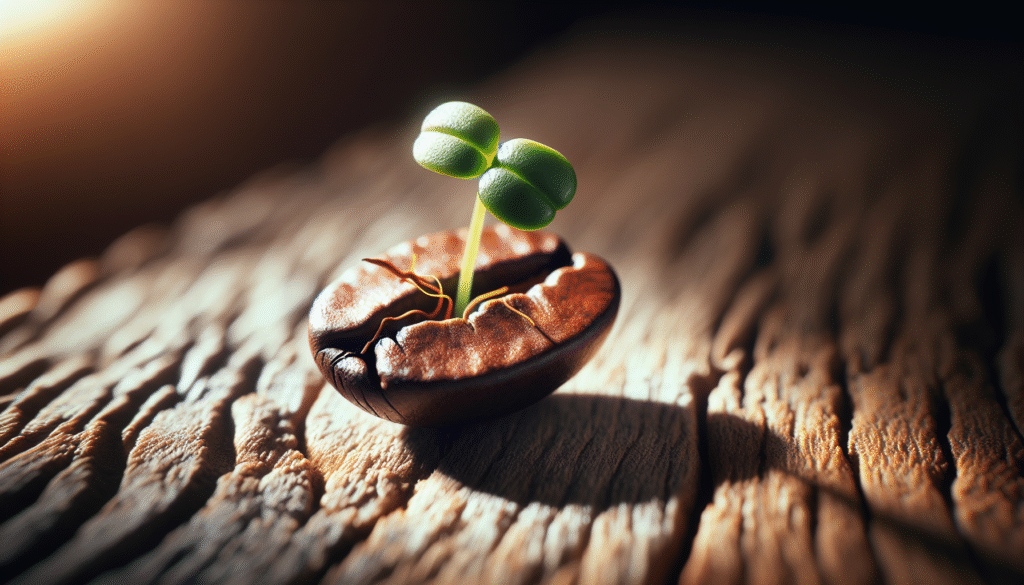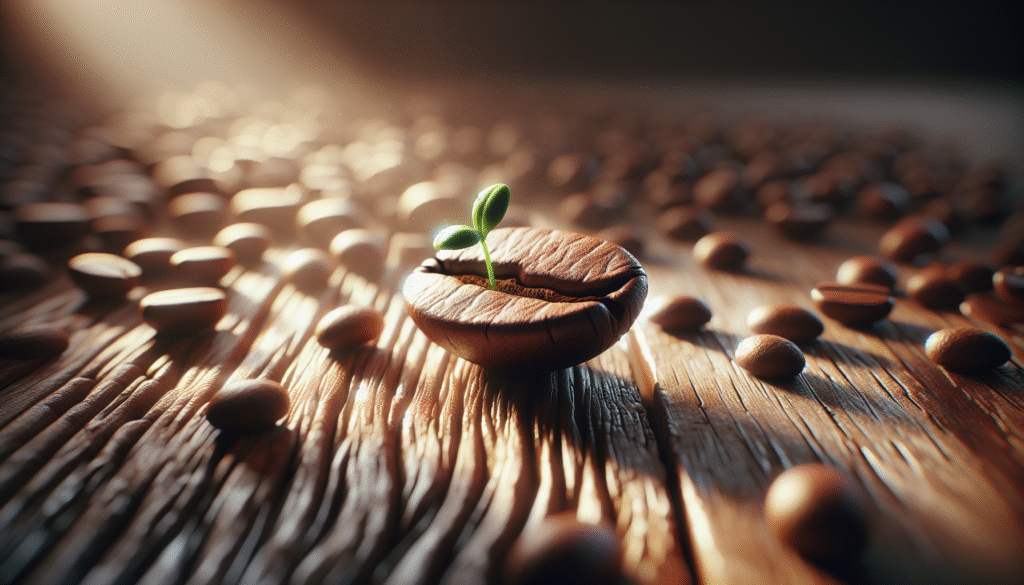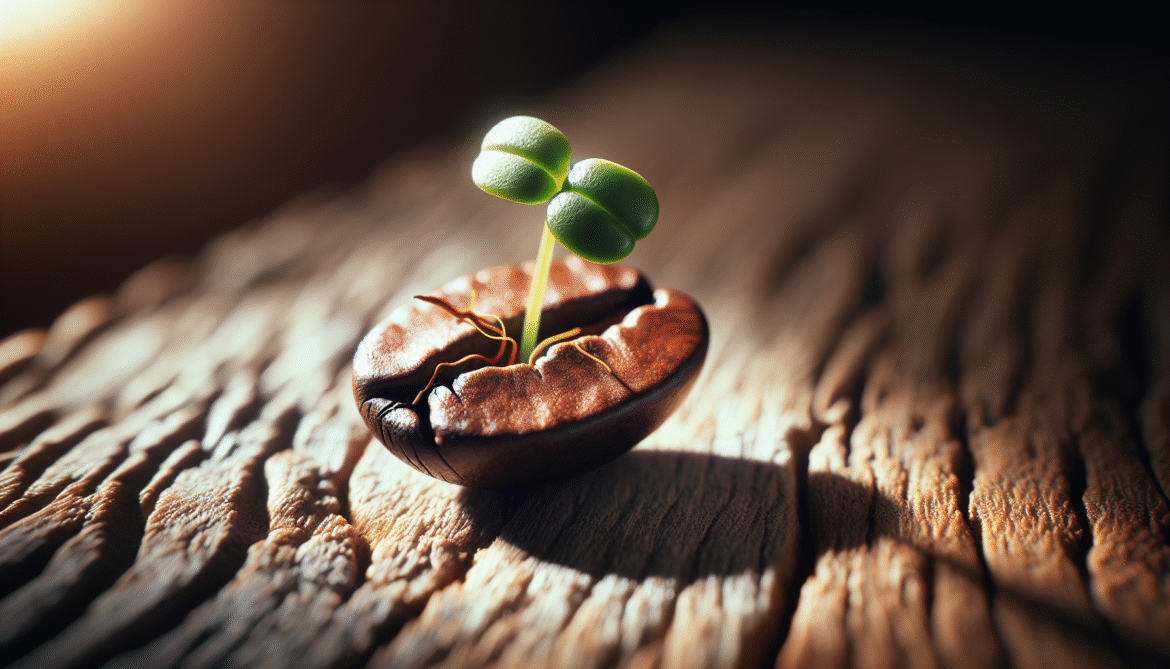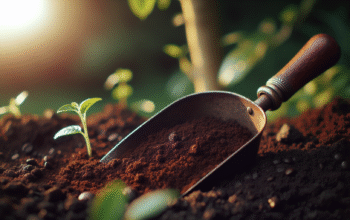Have you ever held a roasted coffee bean and wondered if it could somehow sprout into the same plant that gave you your morning cup?

Can you grow coffee from roasted beans — a realistic guide
You’re about to get a clear, practical answer to whether roasted coffee beans can become coffee plants. This guide will explain the science, walk you through experiments you can safely try, and give you realistic alternatives so you can grow coffee at home without frustration.
Quick answer up front
You won’t get a coffee plant from a roasted bean under normal circumstances. Roasting destroys the living embryo inside the seed, meaning the seed is no longer viable for germination. However, there are useful experiments and important exceptions to understand, and you can grow coffee reliably if you start from the right material.
Why you might think roasted beans could grow
It’s natural to wonder if a coffee bean — which looks like a seed — could be planted to grow another tree. You’ve probably seen seeds that are roasted, puffed, or toasted and still seem intact. That optical similarity leads to the question: does roasting only change flavor, or does it permanently kill the seed?
You should know the difference between a seed as a food item and a seed as a living organism. When a seed is alive, it contains cellular structures and moisture that can produce a seedling. Roasting changes both.
What a coffee “bean” actually is
The coffee bean you grind and brew is actually the seed of the coffee cherry. Inside each cherry are typically two seeds, and those seeds are what you see after processing.
- You’ll find a seed coat (pericarp and parchment removed in processed beans), an embryo (the future plant), and stored food reserves in the endosperm.
- When seeds are unroasted (green), they can remain viable for months to years under proper storage.
- Roasting transforms these biological structures into cooked, inactivated material.
How roasting affects seed viability
Roasting is a thermal process that exposes coffee seeds to very high temperatures, usually between about 180°C and 240°C (356°F–464°F), depending on roast level. That heat:
- Denatures proteins and enzymes essential for cell metabolism.
- Drives out moisture and damages membranes inside cells.
- Destroys the living embryo, rendering the seed incapable of germination.
Think of roasting like cooking an egg: after heat treatment, the cellular machinery that could form a living organism is irreversibly damaged.
Temperature and time matters
Short, low-temperature exposures might damage seeds less than long, high-heat roasts, but commercial roasting is sufficient to kill viability. Even home-roasting temperatures typically exceed the thermal tolerance of seed embryos.
Could any roasting method preserve viability?
It’s extremely unlikely. For a seed to remain viable after heat exposure, you’d need to keep internal temperatures below a few dozen degrees Celsius above ambient — far lower than roasting ranges. Any method that meaningfully changes flavor requires heat levels that kill the embryo.
The only theoretical possibility would be an extremely mild heat exposure that alters surface color but leaves internal tissues intact — a situation that doesn’t practically produce the roasted flavors people expect.
Evidence from science and practice
Seed biology and horticulture studies consistently show that coffee seeds that have undergone roasting processes do not germinate. Seed banks, nurseries, and research institutions always handle green (unroasted) seeds when germination is the goal.
- Nurseries use green seed or seedlings for propagation.
- Research that needs living plant material uses unroasted seeds or tissue culture.
- Anecdotal claims of beans sprouting after roasting have not been reproducibly documented and usually stem from mistakenly planting green or partially processed beans.
How to check whether a bean is viable (green vs roasted)
You can perform simple inspections to determine whether a seed is likely alive or dead.
- Visual: Green beans are greenish to pale yellow, sometimes bluish, and may still have parchment. Roasted beans are brown to black, depending on roast level.
- Break test: Snap or cut a bean. Green seeds are dense and may show a lighter interior and a visible embryo. Roasted beans are brittle, crumbly, and homogeneous.
- Smell: Roasted beans smell of coffee aroma; green beans have a grassy or bean-like scent.
- Float test: Place beans in water. Green seeds that sink are more likely to be dense and potentially viable; roasted beans often float due to gas and reduced density. This is not definitive but can be indicative.
Use a table for quick comparison:
| Characteristic | Green (unroasted) bean | Roasted bean |
|---|---|---|
| Color | Pale green/blue/olive | Brown to black |
| Texture | Dense, pliable | Brittle, crispy |
| Smell | Grassy, raw | Coffee aroma, roasted |
| Internal structure | Visible embryo/endosperm | Cooked, homogenized |
| Germination potential | Possible (if fresh and stored well) | Essentially none |
If roasted beans can’t grow, why do some people claim sprouts?
Most reports of roasted beans sprouting are due to confusion or mix-ups. Common reasons include:
- Planting green beans that happened to be in a bag of roasted beans (rare but possible in small-scale processing).
- Planting coffee cherry pits (unroasted seeds) from fresh cherries that were mistaken for roasted beans.
- Seeing mold or fungal growth on a roasted bean that looks like a sprout.
- Misreporting or misremembering the exact input material.
If you believe you saw a roasted bean sprout, the most likely explanation is that the seed wasn’t actually roasted or it was contaminated by viable seed material nearby.
Experimental approach: what you can try safely
If you’re curious and want to experiment, you can run a controlled test to see for yourself. This is more about understanding processes than expecting success.
- Get clearly labeled green coffee seeds (unroasted) and roasted beans from different sources.
- Set up three groups: green seeds (positive control), roasted beans from a commercial roast (test A), and home-roasted beans roasted lightly (test B).
- Use the same germination protocol for all groups: pre-soak, seedbed or germination paper, warm, humid conditions (20–27°C / 68–81°F), and consistent moisture.
- Observe for 4–8 weeks.
You’ll almost certainly see germination in the green seed group and none in the roasted groups. Document your observations to learn how roasting affects seed structure and behavior.
Recommended germination protocol for green coffee seeds
You’ll want to replicate proper nursery conditions if you test this with green seeds:
- Soak seeds in clean water for 12–24 hours.
- Place seeds in a warm, moist medium: sterilized sand, peat, or germination paper.
- Keep temperature around 24°C (75°F).
- Maintain high humidity and diffuse light.
- Expect germination in 2–8 weeks depending on variety and freshness.
Growing coffee the realistic way: start with the right material
If you want to grow coffee, use green seeds or seedlings. That gives you a high chance of success.
- Buy green coffee seeds from reputable suppliers labeled for planting (not meant for roasting).
- Purchase seedlings or young plants from nurseries if you want faster results.
- Use Arabica (Coffea arabica) or Robusta (Coffea canephora) depending on climate: Arabica prefers cooler highland climates; Robusta tolerates hot, lowland, and more disease-resistant.
Step-by-step guide to growing coffee from green beans
This area will help you grow coffee successfully if you commit to the proper starting material.
Step 1: Choose the right species and seed source
You should pick seeds suited to your climate and obtain seeds meant for propagation. Genetically superior varieties are available with disease resistance and flavor traits.
Step 2: Pre-treatment and storage
Green coffee seeds must be fresh and stored properly prior to planting. You can extend viability by keeping seeds dry, cool, and away from direct sunlight.
Step 3: Germinate
Follow the germination protocol described earlier. Keep records of germination rate and conditions to refine your technique.
Step 4: Transplant to nursery pots
Once seedlings have a few true leaves, transplant them into small pots with a rich, well-draining medium. Provide shade and consistent moisture.
Step 5: Harden off and plant out
When seedlings are sturdy and conditions are right, gradually acclimate them to higher light levels and transplant into their final location. Keep soil moist and apply mulch.
Step 6: Ongoing care
You’ll prune, fertilize, irrigate, and protect from pests and disease over the years. Coffee plants typically take 2–5 years to produce cherries depending on species and growing conditions.
Conditions coffee plants need
Coffee plants aren’t difficult, but they have preferences that influence yield and flavor.
- Light: Bright, diffused light; not full midday sun for young plants (Arabica prefers partial shade).
- Temperature: Arabica thrives at 15–24°C (59–75°F); Robusta is more tolerant to heat.
- Soil: Well-draining, rich in organic matter, slightly acidic (pH 6–6.5).
- Water: Consistent moisture without waterlogging; good drainage is essential.
- Altitude: Arabica prefers high elevations (800–2,000 m) for best flavor; Robusta is lower altitude tolerant.

Timeline: how long until you’ll see cherries
You should set realistic expectations: coffee is a long-term crop.
- Germination: 2–8 weeks for green seeds.
- Seedling to transplantable plant: several months.
- First yield: 2–5 years for seedlings; grafted or advanced nursery stock may fruit earlier.
- Full production: 5–7 years for stable yields and consistent flavor.
Common problems and how you fix them
Growing coffee presents typical horticultural challenges. You should monitor for these issues:
- Leaf yellowing: Could be nutrient deficiency or water stress; check pH and watering schedule.
- Pests: Aphids, mealybugs, scale can appear; use integrated pest management — biological controls, soap sprays, or appropriate insecticides.
- Diseases: Coffee leaf rust (Hemileia vastatrix) is a major concern in many regions. Resistant varieties and good cultural practices help.
- Poor flowering/fruiting: Nutrient balance, pruning, and environmental cues affect flowering; ensure proper fertilization and stable conditions.
Table: Basic care schedule for young coffee plants
| Stage | Frequency | Actions |
|---|---|---|
| Seed germination | Daily | Keep medium moist, maintain warm temp |
| Seedling (0–6 months) | 3–4 times weekly | Watering, light feeding, protect from harsh sun |
| Young plant (6–24 months) | Weekly feeding | Gradually increase fertilizer, transplant as needed |
| Mature plant (>24 months) | Seasonal | Prune annually, manage pests/diseases, harvest when ripe |
Alternatives if you only have roasted beans
If you only have roasted beans and want to grow coffee, here are realistic alternatives that still let you enjoy the process:
- Buy green beans intended for planting from specialty suppliers.
- Purchase a young plant or cutting from a nursery.
- Try growing other coffee-related plants from scraps, such as ornamental coffee plants sold in garden centers (they’re already potted and ready).
- Use roasted beans in decorative or educational projects (e.g., seed anatomy demonstration using green vs roasted beans) rather than planting.
Ethical and sustainability considerations
If you pursue coffee growing, consider sourcing seeds responsibly and supporting smallholder producers. If you buy green seed stock, try to purchase from suppliers that preserve varietal biodiversity and support fair trade.
You should also be mindful of using land and water resources efficiently and avoiding contributing to monoculture practices that harm ecosystems.
FAQs
Can a lightly roasted bean sprout?
It’s effectively impossible. Even brief roasting causes internal damage sufficient to prevent germination. If you see a sprout, check if the bean was actually roasted.
Will old green beans germinate?
Green coffee seeds lose viability over time. Freshly processed seeds stored at cool temperatures germinate best. Older seeds may have low germination rates.
Can I use espresso beans or dark roast for experiments?
No — any commercial roast is high enough heat to kill the embryo. Use green beans if you want germination.
Is there any way to reverse roasting?
No. Roasting causes irreversible physical and chemical changes. You can’t rehydrate or “un-cook” the embryo.
Can I save seeds from coffee cherries at home?
Yes. If you harvest ripe cherries, process them to remove the pulp and dry the seeds gently for planting. Fresh seeds have the highest viability.
Myths you can set aside
You can ignore common myths such as “roasted beans sometimes sprout because the roast wasn’t hot enough” or “soaking roasted beans will revive them.” These don’t align with seed biology. Focusing on proper propagation methods will save you time and disappointment.
Growing coffee in pots vs in the ground
You can grow coffee in a pot or in the ground, depending on your climate and space.
- Pots: Great for patio growers or colder climates since you can move plants indoors during winter. Use rich potting mix, and repot as the plant grows.
- Ground: Better for long-term production in suitable climates. Provides more root space and stability.
Pruning and shaping for higher yields
Pruning coffee plants helps manage size and encourages branching, which affects flower and fruit production.
- Young plants: Prune to form a strong scaffold and promote lateral branches.
- Mature plants: Light annual pruning to remove dead wood, shape canopy, and stimulate new growth.
Harvesting and processing basics
When your plants produce cherries, harvest at peak ripeness for best flavor.
- Harvest by hand or strip harvest depending on scale.
- Process cherries quickly: wet processing (fermentation + washing) or dry processing (sun-drying whole cherries) are common methods.
- After processing, dry the seeds to safe moisture levels before storing or planting.
Final practical recommendations
If your goal is to grow coffee, stop treating roasted beans as planting material and choose one of these options:
- Buy seeds labeled for planting (green beans).
- Buy seedlings or small plants from a nursery.
- If you’re motivated to test the limits of seed viability, run a controlled experiment with green and roasted samples, but expect roasted beans to fail.
By choosing the correct starting material you’ll save time and experience the real satisfaction of growing coffee.
Summary
You can’t realistically grow coffee from roasted beans because roasting destroys the living embryo inside the seed. If you want to cultivate coffee, use green seeds or nursery plants, follow proper germination and care protocols, and be patient — coffee is a long-term crop. Conducting simple experiments will confirm these facts for yourself, and following the practical steps in this guide will help you succeed if you choose to grow coffee the right way.



